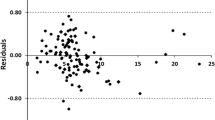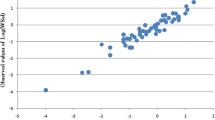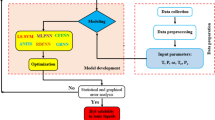Abstract
In this article, quantitative structure–property relationship (QSPR) models were developed for estimation of diffusion coefficients (DCs) of acids at infinite dilution in water. These models were obtained based on molecular descriptors of a set of 65 compounds at 298.15 K. Five date splits are randomly extracted from this dataset. Using a genetic algorithm (GA) variable-selection approach, five molecular descriptors in each split were selected from a set of thousand of them. To analyze the nonlinear behavior of these molecular descriptors, Adaptive neuro-fuzzy inference system (ANFIS) and radial basis function neural network (RBF NN) were used. These models were trained on 52 arbitrary sets of the data, and the remaining 13 sets were employed to evaluate the proposed models. Genetic function approximation (GFA) method could predict DCs of test dataset with high value of squared correlation coefficients of 0.984. QSPR model even gave superior predictions. ANFIS and RBF NN methods when implemented in QSPR model provided the squared correlation coefficients of 0.989 and 0.987, respectively. It is therefore suitable to be used in the proposed QSPR models, especially when applied with ANFIS method, to obtain DC of acids at infinite dilution in water instead of other expensive and complicated experiments.



Similar content being viewed by others
References
Liu JG, Luo GS, Pan S, Wang JD (2004) Diffusion coefficients of carboxylic acids in mixed solvents of water and 1-butanol. Chem Eng Process 43:43–47
Xu J, Chen B, Xu W, Zhao S, Yi C, Cui W (2007) 3D-QSPR modeling and prediction of nonlinear optical responses of organic chromophores. Chemom Intell Lab Syst 87:275–280
Niazi A, Jameh-Bozorghi S, Nori-Shargh D (2008) Prediction of toxicity of nitrobenzenes using ab initio and least squares support vector machines. J Hazard Mater 151:603–609
Chen HF (2008) Quantitative predictions of gas chromatography retention indexes with support vector machines, radial basis neural networks and multiple linear regression. Anal Chim Acta 609:24–36
Li L, Xie S, Cai H, Bai X, Xue Z (2008) Quantitative structure–property relationships for octanol–water partition coefficients of polybrominated diphenyl ethers. Chemosphere 72:1602–1606
Golmohammadi H, Dashtbozorgi Z (2010) Quantitative structure–property relationship studies of gas-to-wet butyl acetate partition coefficient of some organic compounds using genetic algorithm and artificial neural network. Struct Chem 21:1241–1252
Fatemi MH, Karimian F (2007) Prediction of micelle–water partition coefficient from the theoretical derived molecular descriptors. J Colloid Interface Sci 314:665–672
Modarresi H, Modarress H, Dearden JC (2007) QSPR model of Henry’s law constant for a diverse set of organic chemicals based on genetic algorithm-radial basis function network approach. Chemosphere 66:2067–2076
Khajeh A, Modarress H (2010) QSPR prediction of flash point of esters by means of GFA and ANFIS. J Hazard Mater 179:715–720
Khajeh A, Modarress H (2011) Quantitative structure–property relationship for surface tension of some common alcohols. J Chemom 6:333–339
Khajeh A, Modarress H (2011) Quantitative structure–property relationship prediction of liquid thermal conductivity for some alcohols. Struct Chem. doi:10.1007/s11224-011-9828-6
Nantasenamat C, Isarankura-Na-Ayudhya C, Naenna T, Prachayasittikul V (2008) Prediction of bond dissociation enthalpy of antioxidant phenols by support vector machine. J Mol Graph Model 27:188–196
Akcayol MA (2004) Application of adaptive neuro-fuzzy controller for SRM. Adv Eng Softw 35:129–137
Khajeh A, Modarress H, Rezaee B (2009) Application of adaptive neuro-fuzzy inference system for solubility prediction of carbon dioxide in polymers. Expert Syst Appl 36:5728–5732
A Khajeh A, Modarress H (2010) Prediction of solubility of gases in polystyrene by adaptive neuro-fuzzy inference system and radial basis function neural network. Expert Syst Appl 37:3070–3074
Yaws CL (2003) Yaws’ handbook of thermodynamic and physical properties of chemical compounds. Knovel Corp., Norwich
http://www.michem.disat.unimib.it/chm/. Accessed 11 Sept 2009
Rogers D, Hopfinger AJ (1994) Application of genetic function approximation to quantitative structure–activity relationships and quantitative structure–property relationships. J Chem Inf Comput Sci 34:854–866
Jang J (1993) ANFIS: adaptive network-based fuzzy inference systems. IEEE Trans Syst Man Cybernet 23:665–685
Sugeno M (1985) Industrial applications of fuzzy control. Elsevier, Amsterdam
Chang FJ, Chang YT (2006) Adaptive neuro-fuzzy inference system for prediction of water level in reservoir. Adv Water Resour 29:1–10
Todeschini R, Consonni V (2000) In: Manhold R, Kubinyi H, Temmerman H (eds) Handbook of molecular descriptors. Wiley-VCH, Weinheim
Chiu SL (1994) Fuzzy model identification based on cluster estimation. J Intell Fuzzy Syst 2:267–278
Yager R, Filev D (1994) Approximate clustering via the mountain method. IEEE Trans Syst Man Cybernet 24:1279–1284
Loukas YL (2001) Adaptive neuro-fuzzy inference system: an instant and architecture-free predictor for improved QSAR studies. J Med Chem 44:2772–2783
Author information
Authors and Affiliations
Corresponding author
Rights and permissions
About this article
Cite this article
Khajeh, A., Rasaei, M.R. Diffusion coefficient prediction of acids in water at infinite dilution by QSPR method. Struct Chem 23, 399–406 (2012). https://doi.org/10.1007/s11224-011-9879-8
Received:
Accepted:
Published:
Issue Date:
DOI: https://doi.org/10.1007/s11224-011-9879-8




